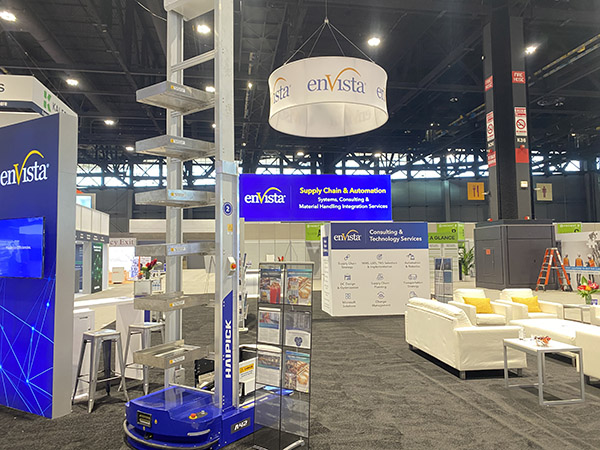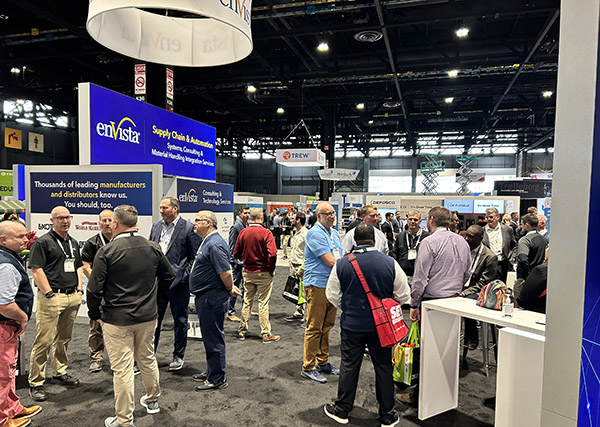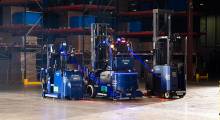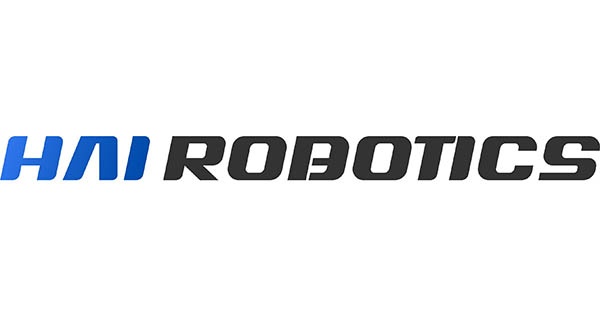At ProMat in Chicago last week, numerous companies touted their technologies as solutions to supply chain problems. Less visible than robots but no less important were the integrators and consultancies that help deploy and manage robots in warehouses and other facilities. Among those Robotics 24/7 spoke with was enVista LLC, which offers to help leading brands with robotics integration.
“The show has gone well for us,” said Mike Kasperski, senior vice president and automation group leader at enVista. “Our sessions were full, and we've had a lot of leads.”
enVista, which has offices in Carmel, Ind., and Chicago, has been growing its robotics team. The company has expanded from conveyors to integrating collaborative and mobile robots for picking, packing, and palletization.
Robotics 24/7 also spoke with Tom Stretar, vice president of technology, and Kyle Smith, vice president of automation, about enVista's perspective on the growing demand for automation.
What did enVista have to show at ProMat?
Stretar: We had our largest booth ever, and we unveiled a video case study of e-commerce and sporting goods [see below].
Smith: While we didn't have robots in our booth this year, because of the sheer number of integrations going on right now, we did unveil a new standardized product and the case study.
enVista provides customers a roadmap to automation
What is enVista's roadmap for supporting supply chain robotics?
Smith: There are a lot of factors to consider. We're looking at what end users are trying to achieve versus what technologies they can afford. Selecting partners must be aligned with organizational goals.
We're looking at low investment and high success, where management as well as workers can get comfortable with automation. For example, in palletizing, one cell is low-risk, and if it works 24/7, it can get people comfortable enough with automation to move upstream.
If a deployment goes off the roadmap, robotics provides flexibility and repurposability if a contract changes. We're a FANUC integrator, with 200 models of robots ranging in payload from 185 to 500 kg [407.8 to 1,102.3 lb.].
Stretar: Anything that can automate highly manual tasks, such as trailer unloading, can free workers for more value-added tasks. Then there's the issue of retraining and retooling.
So who is responsible for retraining?
Stretar: It applies across automation and warehouse management systems [WMS]. Some companies have their own education—we may partner with them on content.
Sometimes, we do it ourselves. It's not “one size fits all.” Many employees want to do it in their environments, not a classroom. You have to look at the culture of the organization.
With the sporting goods company in the Wichita area, the question was, “Should we go with robots or voice picking as our first step?” It started with voice with the intention of eventually getting to goods-to-person [G2P] systems. All the training was with the voice vendor.
What are some of the key considerations when you're introducing robotics?
Smith: Safety.
Stretar: Fear of job loss. One aspect of training is showing how automation can create jobs. It's multi-sensory—people want to see it, touch it, and visualize it.
We've identified four areas to justify improvements, including very manual processes, the need for speed, the need for reliable data, and the ability to adapt to the market.
Partnerships and the market
How do you identify good partners?
Stretar: We look for accessibility to sales staffers. They're the first touch point in any engagement process, then getting into the actual delivery teams implementing solutions. Finding the right fit for a particular client requires a personal touch.
When we're implementing a WMS, we work with Manhattan and Blue Yonder. We make sure that the IT side can eliminate Vendor A versus Vendor B. It's another opportunity to get the associates' perspective.
Smith: We'll promote the partners we have, but we want to provide our clients with the right technology. FANUC is our partner, but its systems may not be best for every application. We have to be honest with our customers.

What trends are you seeing in supply chain automation?
Smith: Robotics is a very broad field. Some things have evolved, like software and AI for self-guided robots. Vision tools for learning parts and paths are still evolving, but we expect a lot over the next 12 months.
Until the past couple of years, piece picking and picking off a shelf were manual, but companies are now offering vision add-ons. There's a wide variety of robots on the market, from 20 to 1,500 kg [44 to 3,306.9 lb.] to food-ready variants.
Stretar: Even if you're not competing directly with Amazon, we see pressure for speed to market and differentiation. We continue to see interest in some sectors, such as groceries.
We have a couple of big retailers that are looking at G2P and AutoStore because trying to find land for new facilities is a long process.
One electronics provider in the Columbus, Ohio, area wiped out 60% to 70% of a building for an automated storage and retrieval [ASRS] system, with a ton of success. Another client in Upstate New York, a sporting goods retailer, is looking at Brightpick.
ROI and workforce concerns
How can companies be sure of their return on investment (ROI) over time?
Stretar: From a pure labor perspective, if we understand the manual processes, automation can save costs. It goes back to setting expectations for speed and levels of customer service.
We've gotten back to a 3% to 4% unemployment rate, with two jobs available for each person in the North American market. We've reached a tipping point in demand for labor, and the total square footage of warehouses has gone through the roof.
Looking past the short-term corrections, those investing now will be in a good position in six to 18 months. It's also getting easier to add automation to existing facilities.
Smith: A lot of smaller manufacturers want to put robots to replace X number of people per shift or per day, but they need to look at a broader perspective. They can't staff enough production lines, but by introducing robots, they can get more throughput with the same number of people.
If you put in a palletizing robot, it's not a labor reduction or replacement, but a shift, creating opportunities for the people on the floor to learn how to operate and maintain the robot.
What should companies looking to automate keep in mind?
Smith: Keep your associates in mind. There's a lot of value in educating your workforce on new opportunities.
Supply chains are the backbone of global industry. While some are pursuing 24/7 lights-out operations, that's decades away, and they still need employees.
Editor's note: For more around ProMat 2023, visit Robotics 24/7's special coverage page.
About the Author
Follow Robotics 24/7 on Linkedin
Article topics
Email Sign Up


















